ignition Lancia Thema 2012 Owner handbook (in English)
[x] Cancel search | Manufacturer: LANCIA, Model Year: 2012, Model line: Thema, Model: Lancia Thema 2012Pages: 316, PDF Size: 3.85 MB
Page 15 of 316
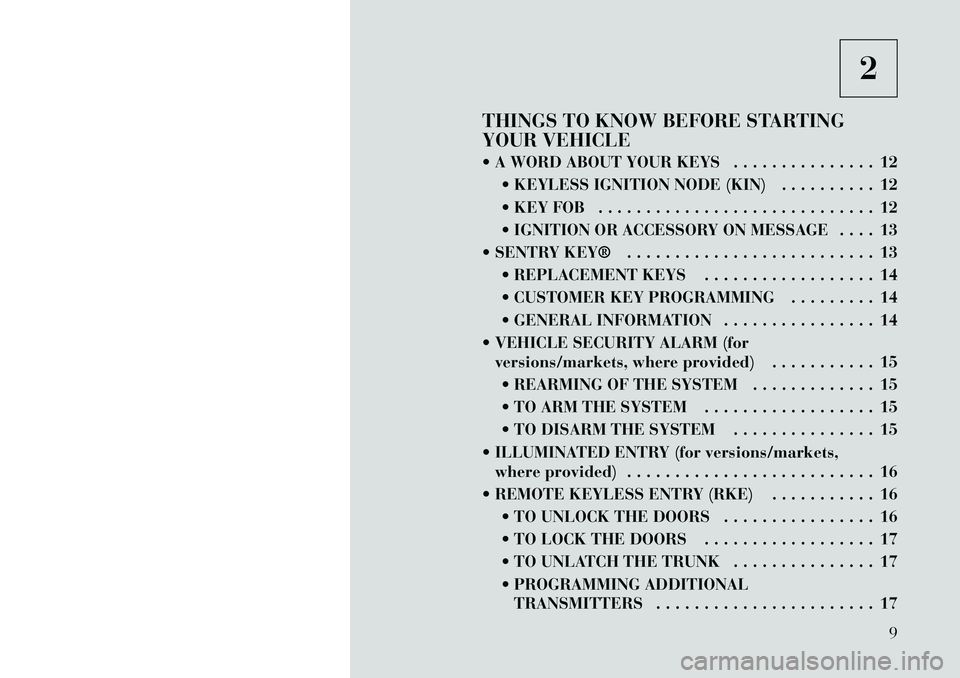
2
THINGS TO KNOW BEFORE STARTING
YOUR VEHICLE
A WORD ABOUT YOUR KEYS . . . . . . . . . . . . . . . 12 KEYLESS IGNITION NODE (KIN) . . . . . . . . . . 12
KEY FOB . . . . . . . . . . . . . . . . . . . . . . . . . . . . . 12
IGNITION OR ACCESSORY ON MESSAGE . . . . 13
SENTRY KEY® . . . . . . . . . . . . . . . . . . . . . . . . . . 13 REPLACEMENT KEYS . . . . . . . . . . . . . . . . . . 14
CUSTOMER KEY PROGRAMMING . . . . . . . . . 14
GENERAL INFORMATION . . . . . . . . . . . . . . . . 14
VEHICLE SECURITY ALARM (for versions/markets, where provided) . . . . . . . . . . . 15
REARMING OF THE SYSTEM . . . . . . . . . . . . . 15
TO ARM THE SYSTEM . . . . . . . . . . . . . . . . . . 15
TO DISARM THE SYSTEM . . . . . . . . . . . . . . . 15
ILLUMINATED ENTRY (for versions/markets, where provided) . . . . . . . . . . . . . . . . . . . . . . . . . . 16
REMOTE KEYLESS ENTRY (RKE) . . . . . . . . . . . 16 TO UNLOCK THE DOORS . . . . . . . . . . . . . . . . 16
TO LOCK THE DOORS . . . . . . . . . . . . . . . . . . 17
TO UNLATCH THE TRUNK . . . . . . . . . . . . . . . 17
PROGRAMMING ADDITIONALTRANSMITTERS . . . . . . . . . . . . . . . . . . . . . . . 17
9
Page 18 of 316
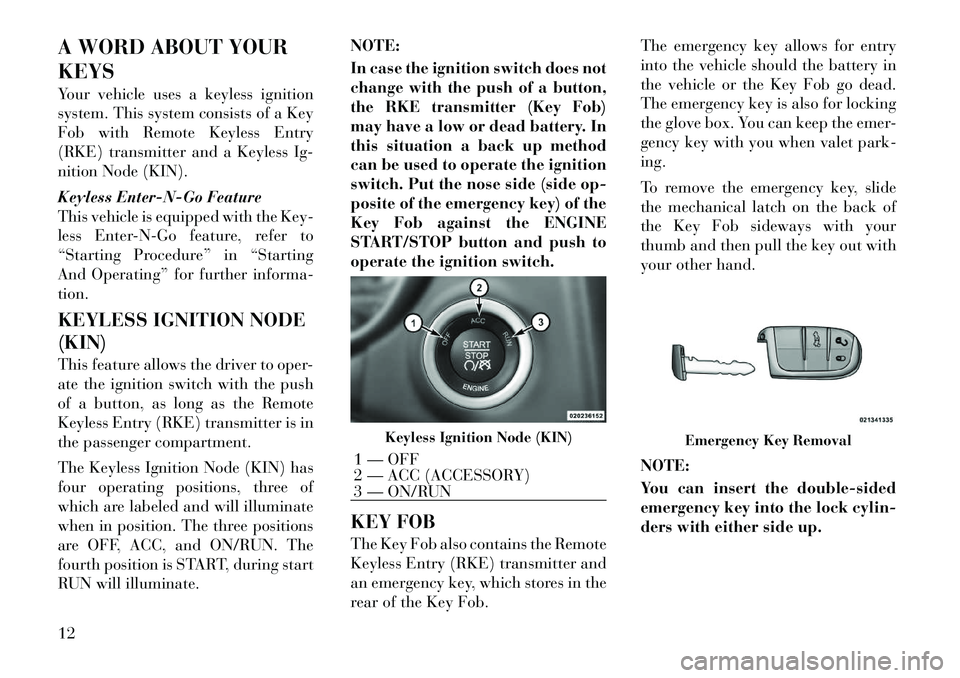
A WORD ABOUT YOUR
KEYS
Your vehicle uses a keyless ignition
system. This system consists of a Key
Fob with Remote Keyless Entry
(RKE) transmitter and a Keyless Ig-
nition Node (KIN).
Keyless Enter-N-Go Feature
This vehicle is equipped with the Key-
less Enter-N-Go feature, refer to
“Starting Procedure” in “Starting
And Operating” for further informa-
tion.
KEYLESS IGNITION NODE
(KIN)
This feature allows the driver to oper-
ate the ignition switch with the push
of a button, as long as the Remote
Keyless Entry (RKE) transmitter is in
the passenger compartment.
The Keyless Ignition Node (KIN) has
four operating positions, three of
which are labeled and will illuminate
when in position. The three positions
are OFF, ACC, and ON/RUN. The
fourth position is START, during start
RUN will illuminate.NOTE:
In case the ignition switch does not
change with the push of a button,
the RKE transmitter (Key Fob)
may have a low or dead battery. In
this situation a back up method
can be used to operate the ignition
switch. Put the nose side (side op-
posite of the emergency key) of the
Key Fob against the ENGINE
START/STOP button and push to
operate the ignition switch.
KEY FOB
The Key Fob also contains the Remote
Keyless Entry (RKE) transmitter and
an emergency key, which stores in the
rear of the Key Fob.The emergency key allows for entry
into the vehicle should the battery in
the vehicle or the Key Fob go dead.
The emergency key is also for locking
the glove box. You can keep the emer-
gency key with you when valet park-
ing.
To remove the emergency key, slide
the mechanical latch on the back of
the Key Fob sideways with your
thumb and then pull the key out with
your other hand.
NOTE:
You can insert the double-sided
emergency key into the lock cylin-
ders with either side up.
Keyless Ignition Node (KIN)
1 — OFF
2 — ACC (ACCESSORY)
3 — ON/RUN
Emergency Key Removal
12
Page 19 of 316
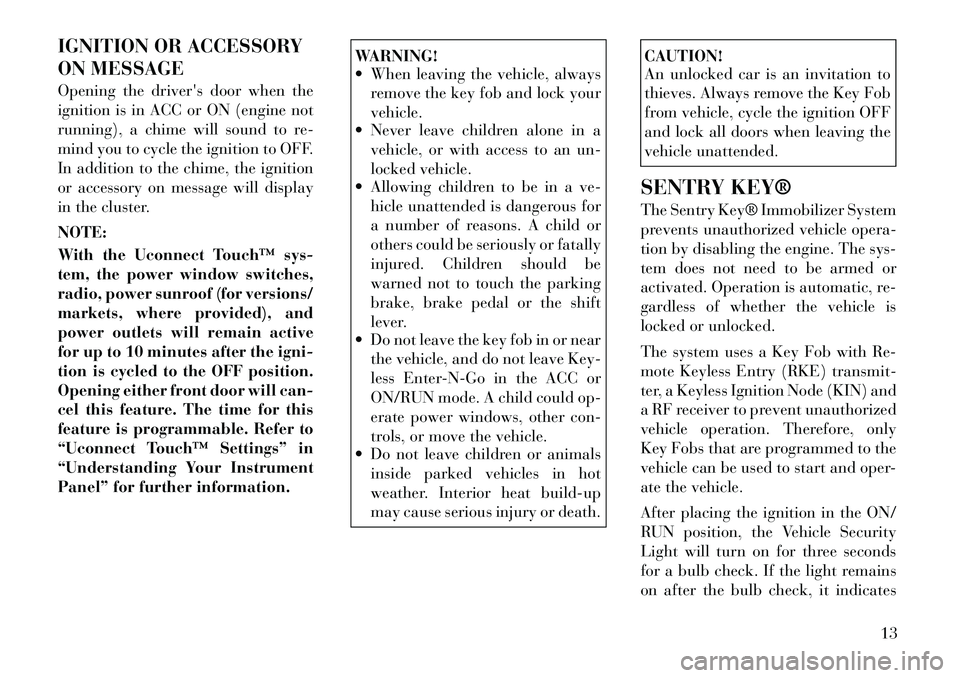
IGNITION OR ACCESSORY
ON MESSAGE
Opening the driver's door when the
ignition is in ACC or ON (engine not
running), a chime will sound to re-
mind you to cycle the ignition to OFF.
In addition to the chime, the ignition
or accessory on message will display
in the cluster.
NOTE:
With the Uconnect Touch™ sys-
tem, the power window switches,
radio, power sunroof (for versions/
markets, where provided), and
power outlets will remain active
for up to 10 minutes after the igni-
tion is cycled to the OFF position.
Opening either front door will can-
cel this feature. The time for this
feature is programmable. Refer to
“Uconnect Touch™ Settings” in
“Understanding Your Instrument
Panel” for further information.
WARNING!
When leaving the vehicle, alwaysremove the key fob and lock your
vehicle.
Never leave children alone in a
vehicle, or with access to an un-
locked vehicle.
Allowing children to be in a ve-
hicle unattended is dangerous for
a number of reasons. A child or
others could be seriously or fatally
injured. Children should be
warned not to touch the parking
brake, brake pedal or the shift
lever.
Do not leave the key fob in or near
the vehicle, and do not leave Key-
less Enter-N-Go in the ACC or
ON/RUN mode. A child could op-
erate power windows, other con-
trols, or move the vehicle.
Do not leave children or animals
inside parked vehicles in hot
weather. Interior heat build-up
may cause serious injury or death.
CAUTION!
An unlocked car is an invitation to
thieves. Always remove the Key Fob
from vehicle, cycle the ignition OFF
and lock all doors when leaving the
vehicle unattended.
SENTRY KEY®
The Sentry Key® Immobilizer System
prevents unauthorized vehicle opera-
tion by disabling the engine. The sys-
tem does not need to be armed or
activated. Operation is automatic, re-
gardless of whether the vehicle is
locked or unlocked.
The system uses a Key Fob with Re-
mote Keyless Entry (RKE) transmit-
ter, a Keyless Ignition Node (KIN) and
a RF receiver to prevent unauthorized
vehicle operation. Therefore, only
Key Fobs that are programmed to the
vehicle can be used to start and oper-
ate the vehicle.
After placing the ignition in the ON/
RUN position, the Vehicle Security
Light will turn on for three seconds
for a bulb check. If the light remains
on after the bulb check, it indicates
13
Page 20 of 316
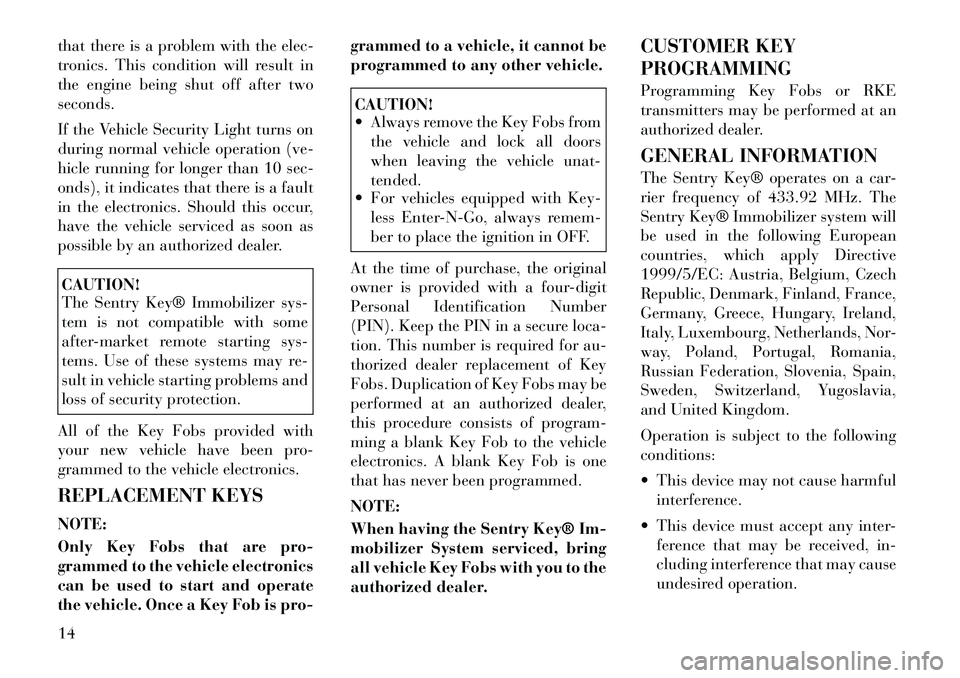
that there is a problem with the elec-
tronics. This condition will result in
the engine being shut off after two
seconds.
If the Vehicle Security Light turns on
during normal vehicle operation (ve-
hicle running for longer than 10 sec-
onds), it indicates that there is a fault
in the electronics. Should this occur,
have the vehicle serviced as soon as
possible by an authorized dealer.CAUTION!
The Sentry Key® Immobilizer sys-
tem is not compatible with some
after-market remote starting sys-
tems. Use of these systems may re-
sult in vehicle starting problems and
loss of security protection.
All of the Key Fobs provided with
your new vehicle have been pro-
grammed to the vehicle electronics.
REPLACEMENT KEYS
NOTE:
Only Key Fobs that are pro-
grammed to the vehicle electronics
can be used to start and operate
the vehicle. Once a Key Fob is pro- grammed to a vehicle, it cannot be
programmed to any other vehicle.
CAUTION!
Always remove the Key Fobs from
the vehicle and lock all doors
when leaving the vehicle unat-
tended.
For vehicles equipped with Key-
less Enter-N-Go, always remem-
ber to place the ignition in OFF.
At the time of purchase, the original
owner is provided with a four-digit
Personal Identification Number
(PIN). Keep the PIN in a secure loca-
tion. This number is required for au-
thorized dealer replacement of Key
Fobs. Duplication of Key Fobs may be
performed at an authorized dealer,
this procedure consists of program-
ming a blank Key Fob to the vehicle
electronics. A blank Key Fob is one
that has never been programmed.
NOTE:
When having the Sentry Key® Im-
mobilizer System serviced, bring
all vehicle Key Fobs with you to the
authorized dealer. CUSTOMER KEY
PROGRAMMING
Programming Key Fobs or RKE
transmitters may be performed at an
authorized dealer.
GENERAL INFORMATION
The Sentry Key® operates on a car-
rier frequency of 433.92 MHz. The
Sentry Key® Immobilizer system will
be used in the following European
countries, which apply Directive
1999/5/EC: Austria, Belgium, Czech
Republic, Denmark, Finland, France,
Germany, Greece, Hungary, Ireland,
Italy, Luxembourg, Netherlands, Nor-
way, Poland, Portugal, Romania,
Russian Federation, Slovenia, Spain,
Sweden, Switzerland, Yugoslavia,
and United Kingdom.
Operation is subject to the following
conditions:
This device may not cause harmful
interference.
This device must accept any inter- ference that may be received, in-
cluding interference that may cause
undesired operation.
14
Page 21 of 316
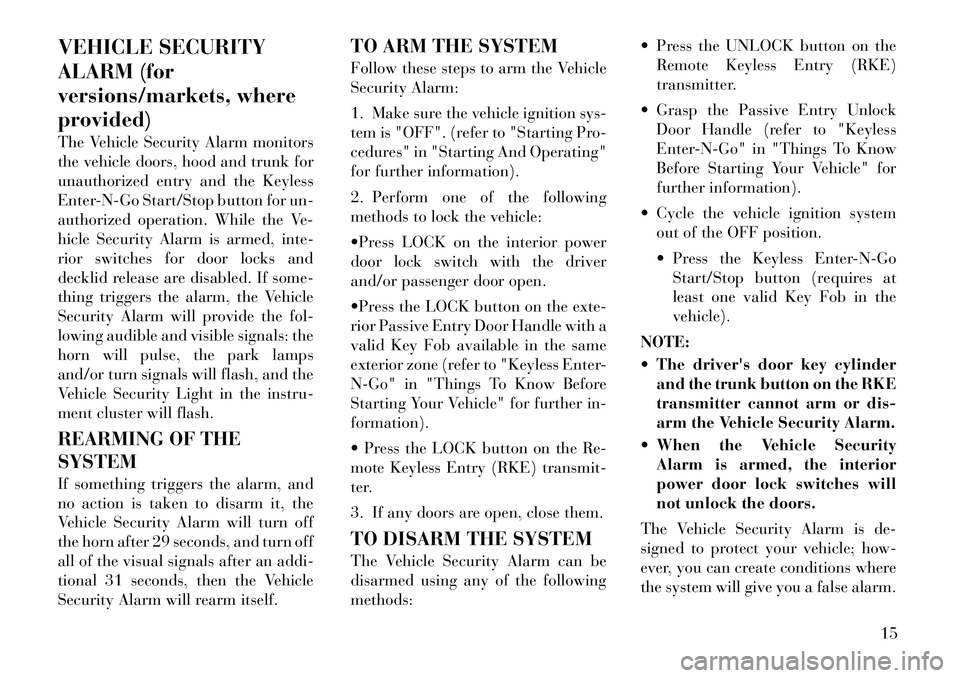
VEHICLE SECURITY
ALARM (for
versions/markets, where
provided)
The Vehicle Security Alarm monitors
the vehicle doors, hood and trunk for
unauthorized entry and the Keyless
Enter-N-Go Start/Stop button for un-
authorized operation. While the Ve-
hicle Security Alarm is armed, inte-
rior switches for door locks and
decklid release are disabled. If some-
thing triggers the alarm, the Vehicle
Security Alarm will provide the fol-
lowing audible and visible signals: the
horn will pulse, the park lamps
and/or turn signals will flash, and the
Vehicle Security Light in the instru-
ment cluster will flash.
REARMING OF THE
SYSTEM
If something triggers the alarm, and
no action is taken to disarm it, the
Vehicle Security Alarm will turn off
the horn after 29 seconds, and turn off
all of the visual signals after an addi-
tional 31 seconds, then the Vehicle
Security Alarm will rearm itself.TO ARM THE SYSTEM
Follow these steps to arm the Vehicle
Security Alarm:
1. Make sure the vehicle ignition sys-
tem is "OFF". (refer to "Starting Pro-
cedures" in "Starting And Operating"
for further information).
2. Perform one of the following
methods to lock the vehicle:
Press LOCK on the interior power
door lock switch with the driver
and/or passenger door open.
Press the LOCK button on the exte-
rior Passive Entry Door Handle with a
valid Key Fob available in the same
exterior zone (refer to "Keyless Enter-
N-Go" in "Things To Know Before
Starting Your Vehicle" for further in-
formation).
Press the LOCK button on the Re-
mote Keyless Entry (RKE) transmit-
ter.
3. If any doors are open, close them.
TO DISARM THE SYSTEM
The Vehicle Security Alarm can be
disarmed using any of the following
methods: Press the UNLOCK button on the
Remote Keyless Entry (RKE)
transmitter.
Grasp the Passive Entry Unlock Door Handle (refer to "Keyless
Enter-N-Go" in "Things To Know
Before Starting Your Vehicle" for
further information).
Cycle the vehicle ignition system out of the OFF position.
Press the Keyless Enter-N-GoStart/Stop button (requires at
least one valid Key Fob in the
vehicle).
NOTE:
The driver's door key cylinder and the trunk button on the RKE
transmitter cannot arm or dis-
arm the Vehicle Security Alarm.
When the Vehicle Security Alarm is armed, the interior
power door lock switches will
not unlock the doors.
The Vehicle Security Alarm is de-
signed to protect your vehicle; how-
ever, you can create conditions where
the system will give you a false alarm.
15
Page 25 of 316
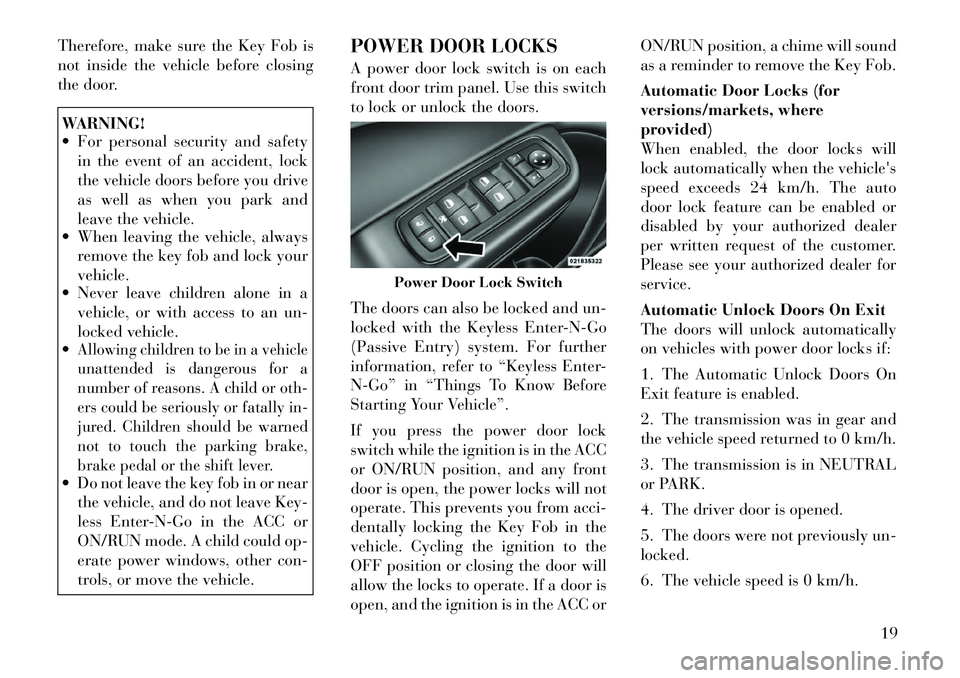
Therefore, make sure the Key Fob is
not inside the vehicle before closing
the door.WARNING!
For personal security and safetyin the event of an accident, lock
the vehicle doors before you drive
as well as when you park and
leave the vehicle.
When leaving the vehicle, always
remove the key fob and lock your
vehicle.
Never leave children alone in a
vehicle, or with access to an un-
locked vehicle.
Allowing children to be in a vehicle
unattended is dangerous for a
number of reasons. A child or oth-
ers could be seriously or fatally in-
jured. Children should be warned
not to touch the parking brake,
brake pedal or the shift lever. Do not leave the key fob in or near
the vehicle, and do not leave Key-
less Enter-N-Go in the ACC or
ON/RUN mode. A child could op-
erate power windows, other con-
trols, or move the vehicle. POWER DOOR LOCKS
A power door lock switch is on each
front door trim panel. Use this switch
to lock or unlock the doors.
The doors can also be locked and un-
locked with the Keyless Enter-N-Go
(Passive Entry) system. For further
information, refer to “Keyless Enter-
N-Go” in “Things To Know Before
Starting Your Vehicle”.
If you press the power door lock
switch while the ignition is in the ACC
or ON/RUN position, and any front
door is open, the power locks will not
operate. This prevents you from acci-
dentally locking the Key Fob in the
vehicle. Cycling the ignition to the
OFF position or closing the door will
allow the locks to operate. If a door is
open, and the ignition is in the ACC or ON/RUN position, a chime will sound
as a reminder to remove the Key Fob.
Automatic Door Locks (for
versions/markets, where
provided)
When enabled, the door locks will
lock automatically when the vehicle's
speed exceeds 24 km/h. The auto
door lock feature can be enabled or
disabled by your authorized dealer
per written request of the customer.
Please see your authorized dealer for
service.
Automatic Unlock Doors On Exit
The doors will unlock automatically
on vehicles with power door locks if:
1. The Automatic Unlock Doors On
Exit feature is enabled.
2. The transmission was in gear and
the vehicle speed returned to 0 km/h.
3. The transmission is in NEUTRAL
or PARK.
4. The driver door is opened.
5. The doors were not previously un-
locked.
6. The vehicle speed is 0 km/h.
Power Door Lock Switch
19
Page 27 of 316

To Unlock From The Driver's Side:
With a valid Passive Entry RKE
transmitter within 1.5 m of the driv-
er's door handle, grab the front driver
door handle to unlock the driver's
door automatically. The interior door
panel lock knob will raise when the
door is unlocked.
NOTE:
If “Unlock All Doors 1st Press” is
programmed all doors will unlock
when you grab hold of the front
driver’s door handle. To select be-
tween “Unlock Driver Door 1st
Press” and “Unlock All Doors 1st
Press”, refer to “Uconnect Touch™
Settings” in “Understanding Your
Instrument Panel” for further in-
formation.To Unlock From The Passenger
Side:
With a valid Passive Entry RKE
transmitter within 1.5 m of the pas-
senger door handle, grab the front
passenger door handle to unlock all
four doors automatically. The interior
door panel lock knob will raise when
the door is unlocked.
NOTE:
All doors will unlock when the
front passenger door handle is
grabbed regardless of the driver’s
door unlock preference setting
(“Unlock Driver Door 1st Press” or
“Unlock All Doors 1st Press”).
Preventing Inadvertent Locking Of
Passive Entry RKE Transmitter In
Vehicle
To minimize the possibility of unin-
tentionally locking a Passive Entry
RKE transmitter inside your vehicle,
the Passive Entry system is equipped
with an automatic door unlock fea-
ture which will function if the ignition
switch is in the OFF position.
If one of the vehicle doors is open and
the door panel switch is used to lockthe vehicle, once all open doors have
been closed the vehicle checks the in-
side and outside of the vehicle for any
valid Passive Entry RKE transmitters.
If one of the vehicle's Passive Entry
RKE transmitters is detected inside
the vehicle, and no other valid Passive
Entry RKE transmitters are detected
outside the vehicle, the Passive Entry
System automatically unlocks all ve-
hicle doors and chirps the horn three
times (on the third attempt ALL
doors will lock and the Passive Entry
RKE transmitter can be locked in the
vehicle).
NOTE:
The vehicle will only unlock the
doors when the doors are locked
using the door panel switch, a
valid Passive Entry RKE transmit-
ter is detected inside the vehicle,
and no valid Passive Entry RKE
transmitter is detected outside the
vehicle. The vehicle will not un-
lock the doors when any of the fol-
lowing conditions are true:
The doors are locked using the
RKE transmitter.Grabbing The Driver's Door Handle
21
Page 29 of 316

There are single window controls on
each passenger door trim panel,
which operate the passenger door
windows. The window controls will
operate only when the ignition is in
the ACC or ON/RUN position.
NOTE:
For vehicles equipped with the
Uconnect Touch™, the power win-
dow switches will remain active
for up to 10 minutes after the igni-
tion is cycled to the OFF position.
Opening either front door will can-
cel this feature. The time is pro-
grammable. Refer to “Uconnect
Touch™ Settings” in “Under-
standing Your Instrument Panel”
for further information.WARNING!
Never leave children in a vehicle
with the Key Fob. Occupants, par-
ticularly unattended children, can
become entrapped by the windows
while operating the power window
switches. Such entrapment may re-
sult in serious injury or death.AUTO-Down Feature
The driver door power window switch
and some model passenger door
power window switches have an
AUTO-down feature. Press the win-
dow switch to the second detent, re-
lease, and the window will go down
automatically.
To open the window part way, press
the window switch to the first detent
and release it when you want the win-
dow to stop.
To stop the window from going all the
way down during the AUTO-down
operation, pull up on the switch
briefly.
AUTO-Up Feature With
Anti-Pinch Protection (for
versions/markets, where
provided)
Lift the window switch to the second
detent, release, and the window will
go up automatically.
To stop the window from going all the
way up during the AUTO-up opera-
tion, push down on the switch briefly.
To close the window part way, lift the
window switch to the first detent and
release it when you want the window
to stop.
NOTE:
If the window runs into any ob-
stacle during auto-closure, it
will reverse direction and then
go back down. Remove the ob-
stacle and use the window
switch again to close the win-
dow.
Any impact due to rough road conditions may trigger the auto-
reverse function unexpectedly
during auto-closure. If this hap-
pens, pull the switch lightly to
the first detent and hold to close
the window manually.
WARNING!
There is no anti-pinch protection
when the window is almost closed.
Be sure to clear all objects from the
window before closing.
23
Page 31 of 316
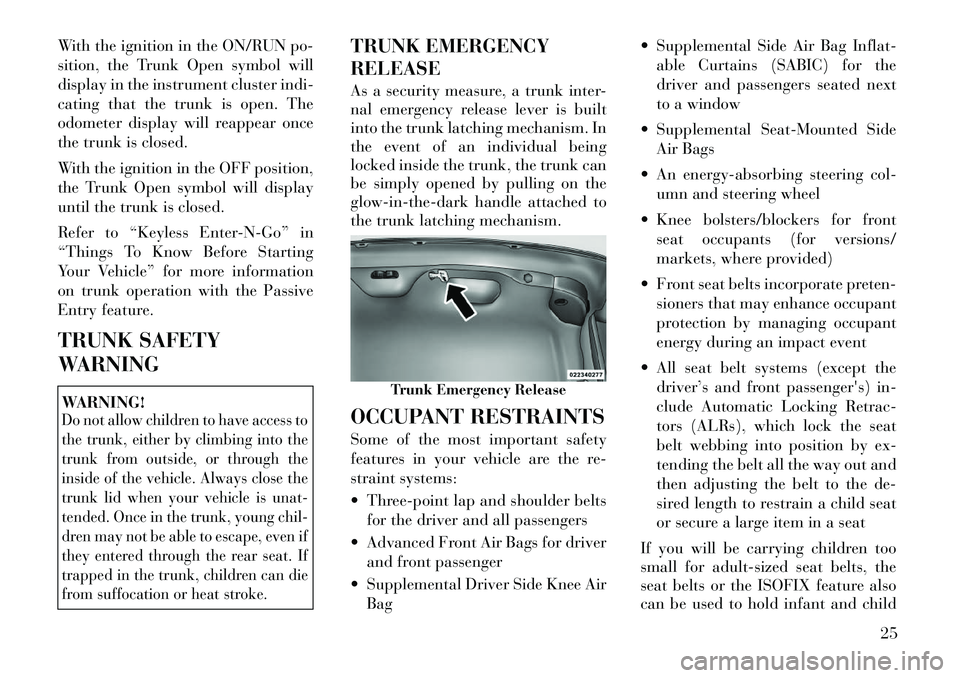
With the ignition in the ON/RUN po-
sition, the Trunk Open symbol will
display in the instrument cluster indi-
cating that the trunk is open. The
odometer display will reappear once
the trunk is closed.
With the ignition in the OFF position,
the Trunk Open symbol will display
until the trunk is closed.
Refer to “Keyless Enter-N-Go” in
“Things To Know Before Starting
Your Vehicle” for more information
on trunk operation with the Passive
Entry feature.
TRUNK SAFETY
WARNINGWARNING!Do not allow children to have access to
the trunk, either by climbing into the
trunk from outside, or through the
inside of the vehicle. Always close the
trunk lid when your vehicle is unat-
tended. Once in the trunk, young chil-
dren may not be able to escape, even if
they entered through the rear seat. If
trapped in the trunk, children can die
from suffocation or heat stroke.
TRUNK EMERGENCY
RELEASE
As a security measure, a trunk inter-
nal emergency release lever is built
into the trunk latching mechanism. In
the event of an individual being
locked inside the trunk, the trunk can
be simply opened by pulling on the
glow-in-the-dark handle attached to
the trunk latching mechanism.
OCCUPANT RESTRAINTS
Some of the most important safety
features in your vehicle are the re-
straint systems:
Three-point lap and shoulder beltsfor the driver and all passengers
Advanced Front Air Bags for driver and front passenger
Supplemental Driver Side Knee Air Bag Supplemental Side Air Bag Inflat-
able Curtains (SABIC) for the
driver and passengers seated next
to a window
Supplemental Seat-Mounted Side Air Bags
An energy-absorbing steering col- umn and steering wheel
Knee bolsters/blockers for front seat occupants (for versions/
markets, where provided)
Front seat belts incorporate preten- sioners that may enhance occupant
protection by managing occupant
energy during an impact event
All seat belt systems (except the driver’s and front passenger's) in-
clude Automatic Locking Retrac-
tors (ALRs), which lock the seat
belt webbing into position by ex-
tending the belt all the way out and
then adjusting the belt to the de-
sired length to restrain a child seat
or secure a large item in a seat
If you will be carrying children too
small for adult-sized seat belts, the
seat belts or the ISOFIX feature also
can be used to hold infant and child
Trunk Emergency Release
25
Page 37 of 316
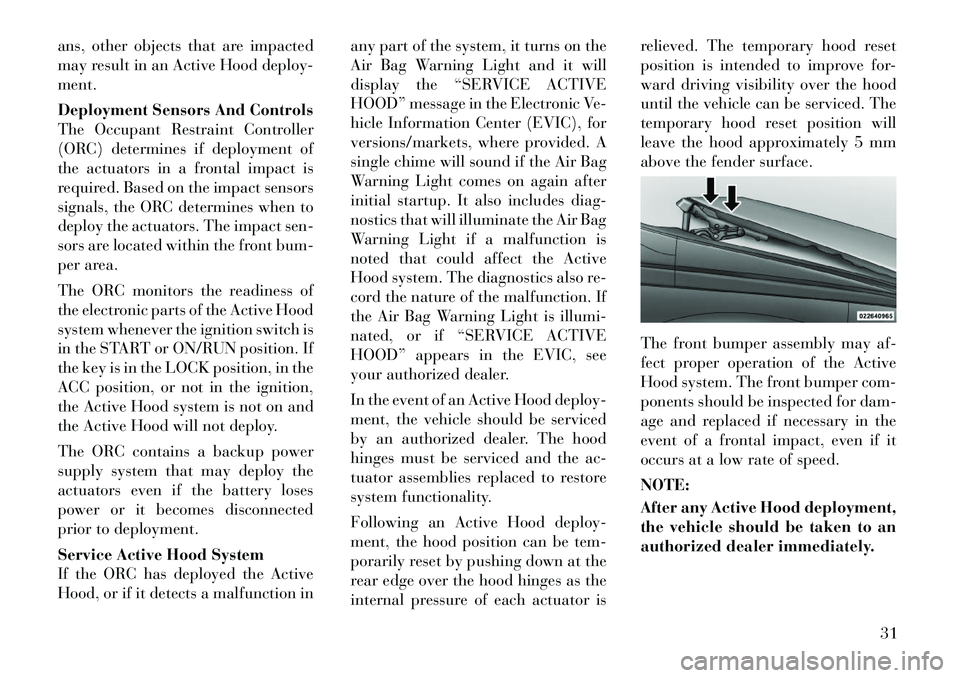
ans, other objects that are impacted
may result in an Active Hood deploy-
ment.
Deployment Sensors And Controls
The Occupant Restraint Controller
(ORC) determines if deployment of
the actuators in a frontal impact is
required. Based on the impact sensors
signals, the ORC determines when to
deploy the actuators. The impact sen-
sors are located within the front bum-
per area.
The ORC monitors the readiness of
the electronic parts of the Active Hood
system whenever the ignition switch is
in the START or ON/RUN position. If
the key is in the LOCK position, in the
ACC position, or not in the ignition,
the Active Hood system is not on and
the Active Hood will not deploy.
The ORC contains a backup power
supply system that may deploy the
actuators even if the battery loses
power or it becomes disconnected
prior to deployment.
Service Active Hood System
If the ORC has deployed the Active
Hood, or if it detects a malfunction inany part of the system, it turns on the
Air Bag Warning Light and it will
display the “SERVICE ACTIVE
HOOD” message in the Electronic Ve-
hicle Information Center (EVIC), for
versions/markets, where provided. A
single chime will sound if the Air Bag
Warning Light comes on again after
initial startup. It also includes diag-
nostics that will illuminate the Air Bag
Warning Light if a malfunction is
noted that could affect the Active
Hood system. The diagnostics also re-
cord the nature of the malfunction. If
the Air Bag Warning Light is illumi-
nated, or if “SERVICE ACTIVE
HOOD” appears in the EVIC, see
your authorized dealer.
In the event of an Active Hood deploy-
ment, the vehicle should be serviced
by an authorized dealer. The hood
hinges must be serviced and the ac-
tuator assemblies replaced to restore
system functionality.
Following an Active Hood deploy-
ment, the hood position can be tem-
porarily reset by pushing down at the
rear edge over the hood hinges as the
internal pressure of each actuator isrelieved. The temporary hood reset
position is intended to improve for-
ward driving visibility over the hood
until the vehicle can be serviced. The
temporary hood reset position will
leave the hood approximately 5 mm
above the fender surface.
The front bumper assembly may af-
fect proper operation of the Active
Hood system. The front bumper com-
ponents should be inspected for dam-
age and replaced if necessary in the
event of a frontal impact, even if it
occurs at a low rate of speed.
NOTE:
After any Active Hood deployment,
the vehicle should be taken to an
authorized dealer immediately.
31